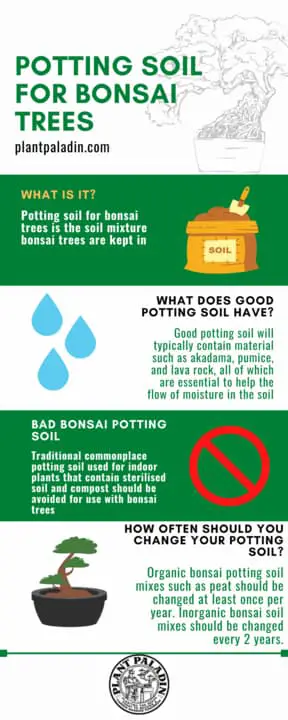This website is supported by its readers. If you click one of my links I may earn a commission. I am also a participant in the Amazon affiliates program and I will also earn a commission from qualified purchases.
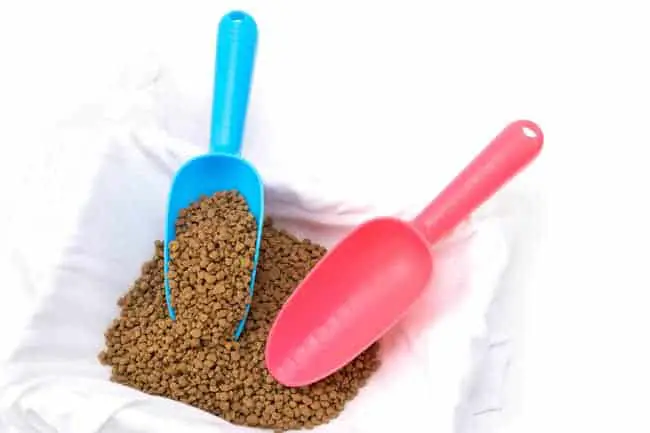
One of the things that I didn’t understand when I first started my bonsai journey was just how important the right bonsai potting soil was. One of my Chinese elms was starting to die and I was shocked when changing the soil drastically improved the health of my bonsai. So what exactly is potting soil for bonsai trees?
Potting soil for bonsai trees is the soil mixture trees are kept in. Good potting soil will typically contain material such as akadama, pumice, and lava rock, all of which are essential to help the flow of moisture in the soil. A good soil mix will allow aeration, water retention and drainage.
So what exactly is the best potting soil for bonsai trees? Can you use any soil for bonsai trees? And do different bonsai species require different soil mixes? Keep reading to find out more!
Just a quick heads up, over the past three years of running Plantpaladin, hundreds of people have asked for product recommendations. As such, You can find my favorite indoor bonsai tree here (link takes you to Bonsaiboy), my favorite outdoor bonsai tree (link takes you to Bonsaiboy), or have a look at all the products I recommend here.
What is potting soil for bonsai trees?
Whilst bonsai owners have different opinions on the most important aspect of keeping bonsai trees, one of the things we can all agree on is the importance of good bonsai soil.
Bonsai potting soil (also known as bonsai soil mix) is one of the most important factors in keeping trees and is very different to normal potting soil mixes for other types of plants and trees.
As such I got in touch with my local botanical gardens, spoke to a few experts and even did a quick survey of 10 plant paladin readers to get to the bottom of what exactly potting soil for bonsai trees was:
- Potting soil for bonsai is the soil mix used in bonsai pots to grow your bonsai trees.
- The soil will have to have 3 main parameters – have enough aeration, hold on to enough moisture, and allow for water and moisture to flow through the soil and pot.
- Bonsai tree potting soil comes in many different varieties, the main two being organic and inorganic potting soil mixes.
- Bonsai soil contains items called grit inside them – these materials will help with the three parameters (moisture retention, moisture flow and aeration)
- Organic soil mixes contain grit material such as peat or leaf litter
- Inorganic soil mixes contain grit materials such as rocks, clay, akadama or other materials.
- Traditional potting soil used for other planting or horticulture activities should be avoided as the needs of bonsai tree potting soil will be different from traditional tree potting soil.
- Different bonsai tree species may also benefit from different bonsai soil mixes or different grit materials.
What are the requirements for bonsai potting soil?
Before we dive into exactly what the best potting bonsai soil is out there on the marketplace, it’s important to understand what the requirements are for great bonsai potting soil.
All good bonsai potting soil then should have the following:
- Good aeration
- Good water retention
- Good drainage
- Have a strong grit component to them
- Have a PH level between 6.5 to 7.5
Let’s explore these in more detail
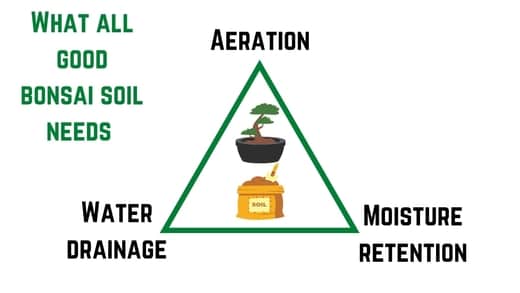
Good aeration
The first element that all good bonsai potting solids have is good aeration.
Bonsai trees, like all plants, need their roots to have access to air to help process food and grow effectively.
Failing to do so can lead to your roots becoming waterlogged and overwatered causing things like root rot or fungal infections.
Good potting soil for bonsai tree mix then will have tiny gaps and air pockets that your roots will benefit from, as well as can help with good bacteria and nutrient flow.
Good water retention
Bonsai trees, especially smaller finger-tip sized bonsai trees are notorious for drying out.
It’s one of the reasons why most bonsai owners recommend watering your bonsai every day or using mosses such as sphagnum moss to increase the amount of moisture in your tree.
Any good bonsai potting soil mix then requires the ability to hold on to water to help give your tree moisture in the periods when you are not watering your tree.
Just remember to only water your bonsai when the topsoil is dry however as overwatering can also be quite common in bonsai.
Drainage
Drainage is also important for bonsai trees – it’s one of the reasons why bonsai tree pots are so expensive and contain a lot of holes.
Having a potting soil mix that allows water to flow through them will prevent your bonsai tree from becoming waterlogged, and avoid the build-up of other materials such as harmful salts which can change the PH of your soil.
Have a strong grit component
Bonsai grit is just a fancy way of saying the small materials used inside bonsai tree soil.
This will typically consist of akadama, volcanic ash, pumice or gravel in inorganic soil mixes or peat or leaf cuttings in organic bonsai mixes.
These different grit components will be the main elements that cause aeration, drainage and water retention in your bonsai soil mix.
These grit elements will be mixed in different proportions to create your bonsai mix.
Have a PH level between 6.5 and 7.5
Bonsai trees tend to perform best when the soil composition is neutral at a 7.
Fertilizers and other components can make your bonsai soil more acidic or alkaline so it is important that the mix you go for remains around this level for the optimal health of your tree.
Bear in mind that regardless of the grit you decide to use in your bonsai soil over time they will decompose and will change the PH levels of your soil mix.
Organic vs inorganic
One important final factor to understand before I give my recommendations is the difference between an organic bonsai soil mix and an inorganic bonsai soil mix.
An organic bonsai soil mix is soil that contains natural elements and grit such as peat moss. Inorganic soil mixes contain inorganic materials such as clay, akadama, pumice and other items.
It’s also worth noting that most bonsai mixes contain a mix of both organic and inorganic soil mixes.
Is inorganic bonsai potting soil better than organic?
Inorganic bonsai soil mixes are typically easier to maintain than organic soil mixes. This is because the organic material in organic soil mixes will decompose much faster than inorganic mixes. Organic soil mixes can also impact the PH level of your soil.
As such, organic soil mixes are also blended with an inorganic material such as akadama or clay to help prevent soil from the negative impacts of the organic materials.
Best potting soil for bonsai trees
So now we know what a good potting soil for a bonsai tree looks like, what are the best potting soils on the marketplace.
I’ve scoured a bunch of my local garden centres and found the following 6 potting soils to be the best mix for bonsai trees.
2 of which are organic and 4 of which are inorganic.
1. Easternleafs organic bonsai mix
Easily the best inorganic bonsai soil mix I found and have used in the past is Easternleafs organic bonsai soil mix.
Not only is the organic mix one of the best selling items on the marketplace, but many customers (myself included) have also used this organic soil mix to revive plants that have been damaged by other soil types
The good:
- Works especially well for seedling for bonsai cuttings
- Perfect for dryer climate bonsai trees
- Already premixed saving you time
- Relatively inexpensive
The bad:
- Can take a while to see the effectiveness of the soil
- Less effective the inorganic blends
Rating: 8/10
Where can you get it: Eastern Leaf (link will take you to eastern leaf’s website)
2. Perfect Plants organic bonsai mix
Another fantastic option, especially if you are based outside of the USA would be Perfect Plants organic bonsai mix.
This potting soil mix in particular is very good at new smaller sized bonsai with cuttings growing particularly well with this substance. This potting soil also works well for species such as Junipers, cedars and redwoods in particular.
The good:
- Works especially well for seedling for bonsai cuttings
- 100% organic materials
- Resealable bag, meaning you can store and reuse the soil at your convenience
The bad:
- This soil mix may need to be mixed with other types of grit such as akadama for other types of bonsai species
- Organic material can attract bugs such as aphids and spider mites.
Rating: 7/10
Where can you get it: Amazon (link will take you to Amazon.com)
3. Eastern leaf’s inorganic bonsai mix
In my opinion, there is no better inorganic bonsai soil mix (that does not contain akadama) than eastern leaves inorganic soil mix.
Not only does it contain multiple grit pieces such as pumice, clay and granite, but it also comes pre-mixed saving you time when it comes to repotting your bonsai.
The good:
- Perfect for wet, humid and cold environments so perfect for use in the fall or winter
- Blended perfectly for moisture retention and aeration, meaning you won’t have to worry about your bonsai getting waterlogged
- Prevents freezing roots
- Ready to use saving time in the repotting process
The bad:
- Does not contain any akadama which is arguably the best grit material for bonsai use.
- Only 3 quarts meaning you may need more if you have a larger bonsai collection.
Rating: 8/10
Where can you get it: Eastern Leaf (link will take you to Easternleaf’s website)
4. Eastern leafs akadama bonsai soil mix
Akadama is easily the most common and widely used grit material in bonsai. Any soil mix that does not contain akadama is lacking somewhat.
Luckily eastern leafs akadama blend mixes akadama with volcanic ash for the perfect inorganic bonsai potting soil.
The good:
- Contains both akadama and volcanic ash, both of which are fantastic at letting moisture flow through your tree.
- Great for bonsai and root growth so the ideal soil mix to use during the early spring and summer
- Perfect for shows and is aesthetically pleasing to use – a lot of professional bonsai keepers use this mix specifically
- Super-versatile for use with almost every bonsai.
The bad:
- Other grit materials such as perlite will have to be blended into the mix
- Not the best mix to be used during the winter months
Rating: 9/10
Where can you get it: Eastern Leaf (link will take you to Easternleafs website)
5. Boon bonsai soil mix
An up and coming bonsai soil mix that I experimented with about a year ago that I enjoyed was Superfly’s boon bonsai soil mix.
Not only does this contain akadama and volcanic ash, but it also contains other items making this a fantastic inorganic option.
The good:
- Contains akadama, volcanic ash as well as pumice and extra components making this a great option for an all-round soil mix
- 100% refundable, if you are unhappy with the item, you can return it at no problem
- The mix has been sieved several times to ensure the best possible mix that is ready to use
- Perfect if you use fertilizer in your trees or just want to maintain their current size.
The bad:
- As the bag contains several different types of grit, you can end up with an uneven amount having some items more than others.
- The sizes can be relatively small making this not ideal if you have large quantities of bonsai.
Rating: 9/10
Where can you get it: Amazon (link will take you to Amazon.com)
6. Easternleaf’s akadama, pumice and lava mix
Finally, we save the best till last.
The bonsai soil mix I use the most frequently for my trees is Easternleafs akadama, pumice and lava mix.
Not only does this contain the grit items that I feel are essential for a healthy bonsai soil composition, but it also contains a bunch of other grit material making this the ideal choice.
The good:
- Pre-mixed making this super easy to use, simply pour out the packet and you are good to repot.
- Super-versatile for almost any bonsai tree, regardless of the season
- Fantastic at bonsai aeration – should your tree tend to get waterlogged then this is a great option at increasing the amount of air to your tree’s roots
- Large-sized so enough material for multiple trees
- Won’t attract bugs or creepy crawlies to your tree due to the inorganic nature of the soil.
The bad:
- Delivery times can take a while due to limited supply ( the item is a best seller so is in high demand)
- If your bonsai tree already gets enough air or is smaller in size then I would opt for a different soil blend that has less aeration.
Rating: 10/10
Where can you get it: Easternleaf (link will take you to the Easternleaf website)
Best potting soil for bonsai trees ranking
Now I appreciate that there was a lot of information to run through so to help simplify things, I’ve put together a quickie table below comparing the different soil mixes based on a few different parameters.
| Brand | Good aeration | Good Moisture retention | Good moisture flow | Suitable for all species | Suitable for all seasons | Overall rating |
| Easternleaf Organic Mix | Yes | No | Yes | Dry and tropical species only | Summer | 8/10 |
| Perfect Plants Organic Mix | No | Yes | No | Yes | Spring and Summer only | 7/10 |
| Easterleaf inorganic mix | Yes | No | Yes | Yes | Fall/Winter | 8/10 |
| Easternleaf akadama | Yes | Yes | Yes | Yes | Spring/Summer | 9/10 |
| Boon inorganic bonsai soil mix | Yes | Yes | Yes | Yes | Year-round | 9/10 |
| Easternleaf Akadama, pumice and ash | Yes | Yes | Yes | Yes | Year-round | 10/10 |
As you can see the best choice in my opinion would have to be Easterleafs akadama, pumice and lava mix.
What potting soil should you avoid for bonsai?
Traditional commonplace potting soil used for indoor plants that contain sterilised soil and compost should be avoided for use with bonsai trees. Bonsai trees require specialist potting soil containing inorganic matter such as akadama, organic ash, pumice and gravel.
Avoid then getting potting soil from garden centres as whilst they might be good for other plants, trees and flowers, won’t be able to drain well, will retain too much water and will not allow for enough gas exchange – all of which are essential for the health of your bonsai.
How often should you change your potting soil for bonsai?
Organic bonsai potting soil mixes such as peat should be changed at least once per year. Inorganic bonsai soil mixes such as akadama will last longer and should be changed every 2 years. Failing to replace the potting soil will impact the soil’s PH levels.
This also does not take into consideration if you need to repot your bonsai.
Every time your bonsai needs repotting you will need to use a fresh potting soil mix, especially during the aftercare process.
To help explain this in more detail I’ve put together a table below consisting of all the common materials used in organic and inorganic bonsai potting soil mixes as well as how frequently they need to be changed.
| Material | Organic or inorganic | How frequently should you change |
| Peat | Organic | One per year |
| Compost | Organic | One per year |
| Leaf mulch | Organic | One per year |
| Akadema | Inorganic | 1-2 years |
| Pumice | Inorganic | 1-2 years |
| Gravel | Inorganic | 1-2 years |
| Lava rock | Inorganic | 1-2 years |
| Kyodama | Inorganic | 1-2 years |
What soil do you plant bonsai trees in?
Bonsai trees are potted and planted in either organic or inorganic soil mixes. Organic soil mixes usually contain peat moss and leaf mulch. Inorganic soil mixes usually contain akadama and pumice. Avoid potting bonsai in regular compost or store-bought soil.
What happens if you don’t have good bonsai potting soil
Failure to plant your bonsai tree in good potting soil will cause your tree to hold on to too much water, not get enough air to its roots and cause root rot and fungal infections, which can be fatal in severe cases. Poor soil conditions may also attract unwanted pests.
Do different bonsai species need different soil mixes?
So now we know that bonsai trees require different soil mixes than regular plants. What about the individual species?
After all bonsai trees are vastly different from each other, so do bonsai tree species need different soil mixes?
Bonsai soil mixes will work well for bonsai, regardless of the species of tree. Deciduous trees may benefit from more akadama and a greater emphasis on an organic and inorganic blend. Coniferous trees may benefit from an entirely inorganic soil mix.
These differences however tend to be minute.
Deciduous tree bonsai mix
Deciduous trees are trees that lose their leaves at the end of a season.
A good inorganic bonsai mix for them then is as follows:
50% Akadama, 25% volcanic lava rock, 25% pumice
Should you decide to mix organic and inorganic soil mixes I found the following works well:
50% akadama, 30%Volcanic lava rock, 20% organic mix(such as peat)
Coniferous tree bonsai mix
Coniferous trees are evergreen tree species such as Junipers or pine that stay green and do not lose their leaves year-round.
The following inorganic bonsai mix then works well:
50% Akadama, 25% volcanic lava rock, 25% pumice
Should you wish to mix inorganic and organic materials to create a mixed blend the following works well:
60% akadama, 30% volcanic lava rock, 10% organic mix (such as peat)
Should bonsai potting soil contain peat?
Peat moss soil is a fantastic organic potting soil mix option to use for keeping bonsai trees. For best results mix the peat soil with an inorganic grit material such as akadama and pumice. Ensure that the peat soil is kept for no longer than one year before repotting your bonsai.
Cactus soil is also a fantastic alternative to use as an organic bonsai soil mix.
What is bonsai grit in potting soil?
Bonsai grit is the organic or inorganic material used in bonsai soil. Examples of bonsai grit include akadama, clay, volcanic ash, pumice and granite. Bonsai grit helps the flow of moisture, allows for better aeration and also retains water, all of which are essential for a healthy soil mix.
What is the best PH level for bonsai soil?
A neutral soil PH level of 7.0 is the best for bonsai maintenance. Some bonsai species prefer slightly acidic soil, so a good PH range for soil would be between 6.5 to 7.5. Avoid Ph levels higher than 8.0 which can kill your bonsai.
What does bonsai potting soil contain?
Bonsai potting soil typically contains a mix of organic or inorganic materials known as grit. These materials are typically akadama, volcanic ash, granite, stones, pebbles or peat moss. These materials help with aeration, moisture retention and moisture flow
Can I use regular potting soil for bonsai?
Bonsai specific potting soil should be used for keeping bonsai trees. Traditional commonplace potting soil found in garden centres used for other indoor plants should be avoided. Bonsai trees have specific requirements that regular store-bought potting soil will not be able to meet.
Bespoke custom potting soil bought from a specialist then will be required.
Study
Finally, I wanted to not just give my opinion and history when it came to potting soil for bonsai trees, but also give some professional insight.
First I got in touch with my local botanical gardens at an event they hosted a few weeks back and asked them about their soil mix.
Here is what they said:
“Any good bonsai potting soil mix will be changed about once per year and in my opinion contain both organic and inorganic material”
Secondly, I asked 10 plant paladin readers their thoughts on if they use organic or an inorganic bonsai soil mix here were the results:
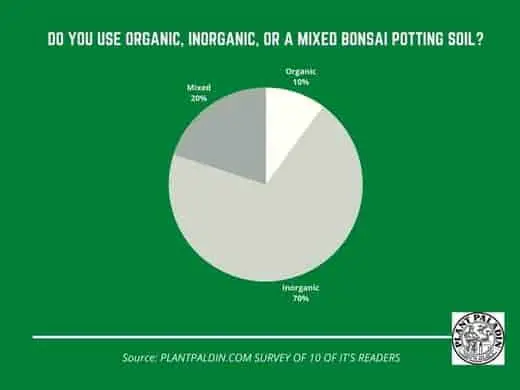
As the results were so skewed towards an inorganic mix, I then asked them what the materials in their potting soil bonsai mix were
Here are the results for:
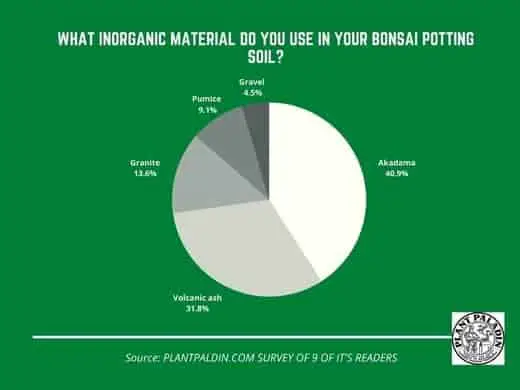
Wrapping things up
So hopefully the post today has been useful in letting you know exactly what passing soil for bonsai trees is.
A lot of you reading this are relatively new to bonsai keeping and so I wanted to share some blog posts which I know would have helped me when I first started bonsai keeping:
- Do squirrels eat bonsai trees
- Do Foxes eat bonsai trees?
- Health benefits of bonsai trees
- Why are bonsai pots shallow?
- Do bonsai trees need sunlight
- Bonsai trees and rainwater
My top picks for the gear you will need!
So like I mentioned earlier, over the past three years of running PlantPaladin, hundreds of people have asked me for my recommendations on the best bonsai gear on the market.
Having spent thousands of dollars on bonsai items these past few years and tested at least 100 bonsai-specific products, I’ve listed my favorite products below – All of which I highly recommend and think you can get great value.
They can purchase directly by clicking the link to take them to Amazon.
Bonsai Tool Set: One of the significant challenges I’ve had is finding a toolset that was not only durable but didn’t break the bank. SOLIGT has recently developed a fantastic bonsai tool set that covers all the tools you need to trim, prune, and repot your trees. – You can grab it here.
Complete Bonsai Set: Many of you will want to grow your bonsai trees entirely from scratch, but finding the varicose seeds, pots, and other items in one place can be challenging. Leaves and Sole then have created a complete bonsai set that I’ve personally used that ticks all the boxes. You can grab it here.
Bonsai wire: The number of times I’ve run out of wire for my bonsai or purchased cheap bonsai wire that doesn’t do the job is embarrassing for me to admit. After a lot of trial and error, I found that using Hotop’s aluminum bonsai wire is one of the best options on the market. This can easily be used for both indoor and outdoor bonsai. You can grab it here.
This post was written by Fehed Nicass who has been passionate about bonsai for over 3 years.

